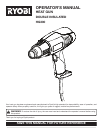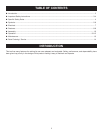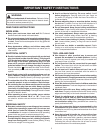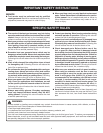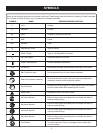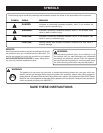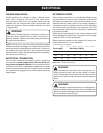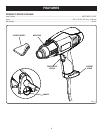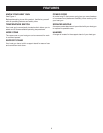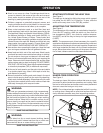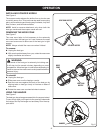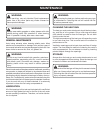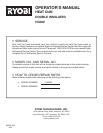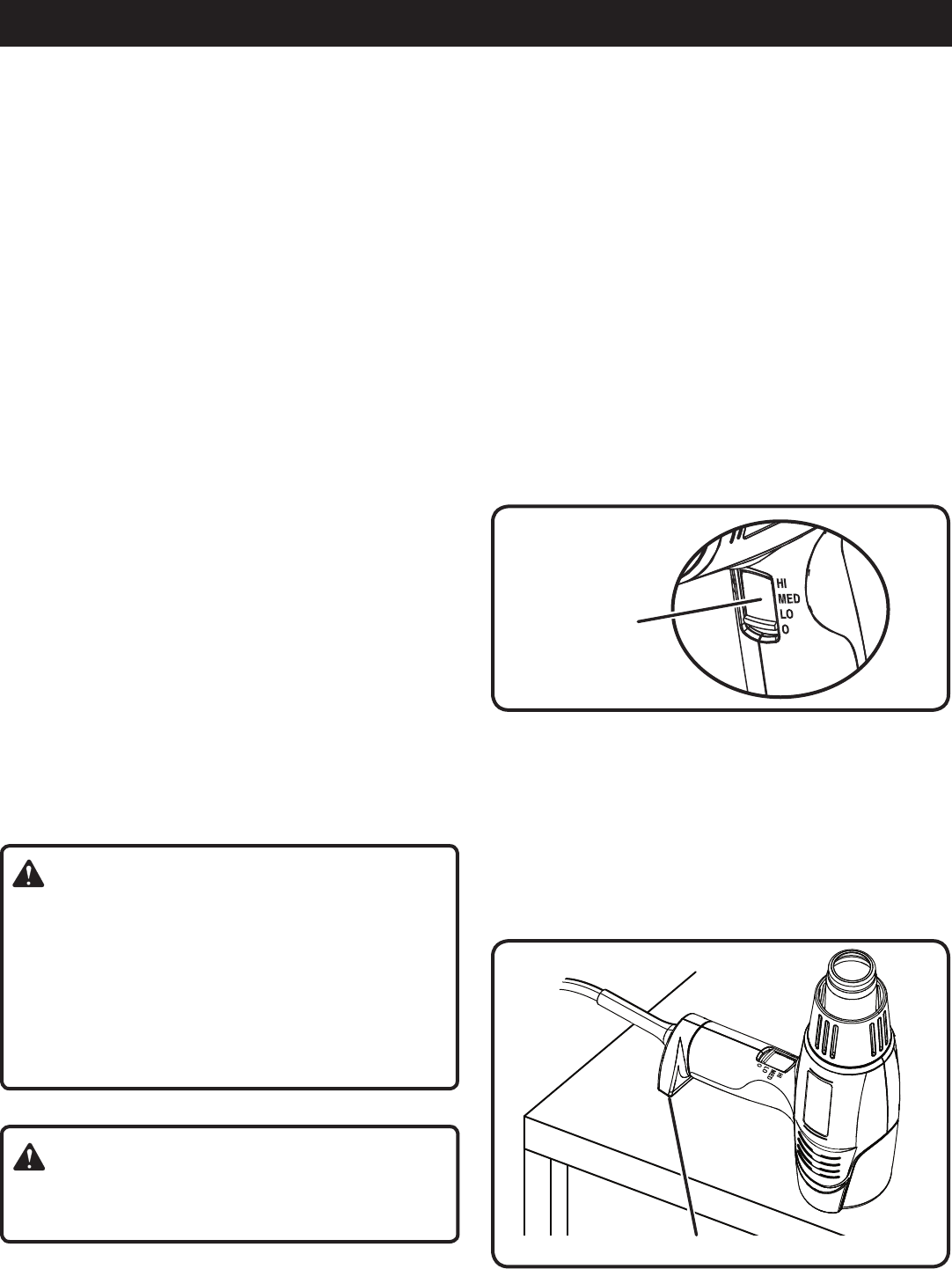
10 11
STARTING/STOPPING THE HEAT GUN
See Figure 2.
The heat gun is started by sliding the power switch upward
into either the HI, MED, or LO position. To stop, slide the
switch all the way down to the OFF (O) position.
ADJUSTING THE TEMPERATURE
See Figure 2.
The temperature of the heat gun is controlled by the switch.
From the OFF position, slide the switch up one click for
low temperature (300˚F), two clicks for medium tempera-
ture (600˚F) and all the way to the top for high temperature
(1100˚F).
NOTE: The proper amount of heat necessary for a specific
application depends on the distance between the nozzle and
workpiece and the length of time heat is applied. Experiment
with scrap materials and start with the lowest temperature
range. Be cautious when working until the proper combina-
tion of heat, distance and time has been determined.
OPERATION
Fig. 2
TEMPERATURE
SWITCH
n Work in one room at a time. Furnishings should be re-
moved or placed in the center of the room and covered.
Work areas should be sealed off from the rest of the
dwelling by sealing doorways with drop cloths.
n Children, pregnant or potentially pregnant women, and
nursing mothers should not be present in the work area
until the work is done and all clean up is complete.
n Wear a dust respirator mask or a dual filter (dust and
fume) respirator mask which has been approved by the
Occupational Safety and Health Administration (OSHA),
the National Institute of Safety and Health (NIOSH), or
the United States Bureau of Mines. These masks and
replaceable filters are readily available at major hardware
stores. Be sure the mask fits. Beards and facial hair may
keep masks from sealing properly. Change filters often.
DISPOSABLE PAPER MASKS ARE NOT ADEQUATE.
n Use caution when operating the heat gun. Keep the heat
gun moving as excessive heat will generate fumes
n Keep food and drink out of the work area. Wash hands,
arms and face and rinse mouth before eating or drinking.
Do not smoke or chew gum or tobacco in the work area.
n Clean up all removed paint and dust by wet mopping the
floors. Use a wet cloth to clean all walls, sills, and any other
surface where paint or dust is clinging. DO NOT SWEEP,
DRY DUST, OR VACUUM. Use a high phosphate detergent
or trisodium phosphate (TSP) to wash and mop areas.
n At the end of work session, put the paint chips and debris
in a double plastic bag, close it with tape or twist ties,
and dispose of properly.
n Remove protective clothing and work shoes in the work
area to avoid carrying dust into the rest of the dwelling.
Wash work clothes separately. Wipe shoes off with a wet
rag that is then washed with the work clothes. Wash hair
and body thoroughly with soap and water.
WARNING:
This heat gun generates extremely high temperatures.
Hidden areas such as behind walls, ceilings, floors, soffit
boards, and other panels may contain flammable materi-
als that could be ignited by the heat gun when working
in these locations. Keep tool in constant motion; do not
stop or dwell in one spot as the panel or material behind
it may ignite. The ignition of these materials may not be
readily apparent and could result in property damage and
injury to persons.
SAVE THIS INSTRUCTION
WARNING:
Do not direct hot tip or nozzle toward clothing, hands
or other body parts. Intense heat from tip or nozzle can
cause serious burns or cause clothing to ignite.
SAVE THIS INSTRUCTION
HANDS-FREE OPERATION
See Figure 3.
The heat gun has a flat bottom surface that acts as a sup-
port stand to allow hands-free operation and cooling. Rest
the tool on a flat surface and make sure the cord placement
does not cause the heat gun to tip over.
NOTE: Do not leave heat gun unattended while it is running
or cooling down. Always set on a flat, level surface with noz-
zle tip directed upwards, away from supporting surface.
Fig. 3
SUPPORT STAND



